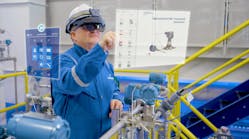Seasons and science: Cyclical changes that affect contaminant detection
Digital technologies have quickly transformed how North American food plants run processes. Machine learning especially is pushing the innovation boundaries in food manufacturing and streamlining production processes. It is a science that requires a deep understanding of the chemical makeup and the molecular structures of foods.
How fats, proteins, carbohydrates and sugars change during processing and storage will initiate a chemical reaction. To the naked eye, and even taste buds, these changes are scarcely noticeable. Yet, for wet and conductive foods — such as bread, meats, dairy products and pre-prepared meals — to a sensitive metal detector inspecting the same foods over an eight-hour shift, they can appear like completely different products.
Thermal changes and water content are the main factors that can interfere with metal detector signals. Dealing with higher amplitudes of product signal can be especially pronounced in meat processing plants that are inspecting varying weights and sizes of joints, some boneless and others boned.
With boneless joints, there is a greater concentration of meat, which means they are denser and consequently weigh more. This water content, which could be intensified by “plumping” — a common practice to maintain tenderized meat products by injecting saltwater or stock — disrupts and mimics the metal detector signal causing traditional systems to react as if there is a metal contaminant present and reject the product.
Known as “product effect,” these false rejects often result in good food being discarded.
Just a slight 5°C change can alter product characteristics
To identify a metal contaminant within conductive products, a metal detector must remove or reduce this “product effect.” The solution is to change the frequency of operation to minimize the effect of the product. But there is a trade-off. Doing this can affect the ability to find different metals. Dropping the frequency tends to enhance ferrous metal detection. Yet, this limits performance when it comes to non-ferrous metals, since the lower end of the frequency is more responsive to magnetic effects of the contamination.
By the same token, the reverse happens when the frequency is taken higher — it starts to limit the ferrous detection capability but enhances the non-ferrous detection.
Simultaneous frequency is the most reliable way to remove product effect without compromising the sensitivity of a metal detector. For example, Fortress Technology uses ARM microprocessors to adapt to these changing product characteristics. This processing technology powers the Fortress Interceptor, enabling it to run real-time analysis of the low-frequency and a high-frequency signal in parallel.
By the same virtue, as products travel through processing facilities, environmental conditions change. Factory temperatures rise and dip. For example, bread dough can warm, causing moisture to gradually evaporate. Alternatively, frozen food can thaw.
A change of just 5°C is enough to affect the product characteristics and disrupt product signals.
Automatic alignment
AutoPhase is a useful tool available on Fortress Phantom, Stealth and Interceptor metal detectors that tracks long-term changes within wet products, adapting and syncing to new characteristics. For example, batch conditions in baked bread can vary slightly between recipes. Technologies like AutoPhase accommodate this gradual change without compromising metal detector sensitivity. And, even products that look different to the metal detector will not be rejected.
Packaging is another common example where AutoPhase technology can help. Whereas inert plastic presents minimal signal, metalized films and the application of print can vary between rolls. And even a small change can present itself as a big signal to a sensitive metal detector. Although once deemed a major challenge for metal detectors, today’s advanced simultaneous frequency systems are much more reliable in inspecting pre-wrapped products.
For food packaged in cans, tins or foil, X-ray inspection systems can play a complementary role.
Cause and effect
The presence of xenobiotic compounds is routinely monitored and tightly controlled by regulatory bodies. However, farming practices, regional soil structures and natural crop cycles, although rare, can also influence the nutrient content of fresh produce. Inspecting potatoes grown, for example, in iron-rich soils might require a slightly different calibration setting to those grown on the other side of the country.
Changeable protein levels in flour are another example of seasonal variations. Seldom would these changes directly affect the performance of inspection systems; however, the raw ingredient changes can influence the chemical composition of a baked product like bread. These changing attributes must be considered.
As a case in point, butter samples recently tested Fortress Technology’s scientific wisdom. Butter is usually categorized as a wet product. However, when the butter samples were run through a Fortress metal detector, it automatically calibrated to a dry product and nobody understood why. Further investigations tracked the cause down to the cattle feed and geographical environmental factors. The produced milk was influencing the butter characteristics and causing it to present to the metal detector as a dry product.
A metal detector that can run multiple frequencies simultaneously is ideal, as it can accurately inspect a variety of conductivities at the same time. Features like single pass product learning and automatic calibration also help, as operators are not constantly resetting the machine to accommodate different product effect, shapes, sizes and orientation.
When it comes to food safety, there is always a cause and a consequence. Having deep-rooted experience about how different food products behave and change, the conditions that cause these reactions, and the relearning limits of inspection equipment is critical.
Eric Garr is a regional sales manager for Fortress Technology. Fortress Technology is a world leader in the design, manufacturing and sales of industrial metal detector systems.



